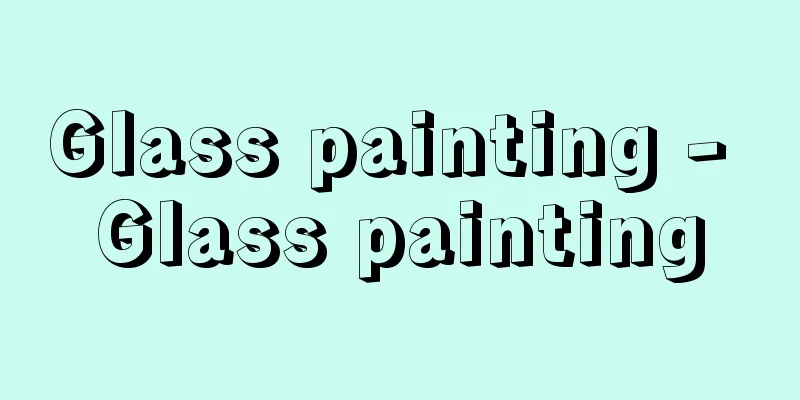Glass painting - Glass painting

|
These paintings are made on the reverse side of a transparent glass plate using mud paints and oil paints in the reverse order to a normal painting, and are viewed from the front. It began in the late 17th century when Eastern European farmers, inspired by stained glass, began creating icons during the off-season. In China, it is called jade oil painting or glass oil painting, and was produced in abundance in the Qing dynasty, mainly in Guangdong. The exotic style of painting Western-style buildings and red-haired people gradually gave rise to Sinicized paintings of flowers and birds, and portraits. During the Edo period, Chinese glass paintings were imported to Japan through Nagasaki, and Nagasaki school artists such as Araki Jogen (1765-1824) and Ishizaki Yushi (1768-1846), who were in the Karae Meki Kishoku school, produced elegant and excellent works influenced by them. At the time, they were called vidro paintings, and Shiba Kokan also painted glass paintings in Okayama on his way back from Nagasaki to Edo in 1789 (Kansei 1) (Kokan's "Saiyu Nikki"). Glass paintings that were introduced to Edo were embodied by Utagawa school ukiyo-e artists into ukiyo-e-style portraits of beautiful women and actors, and Katsushika Hokusai mentioned glass painting techniques in his "Gahon Saishiki Tsu" (1848). Japanese glass painting, which developed in parallel with Western-style painting, began to take on more themes related to the enlightenment movement in the Meiji era, gradually becoming stereotyped, and then rapidly declined after 1897. From the Taisho period to the early Showa period, Koide Nara Shige produced artistic glass paintings with a rich fragrance. In recent years, Western-style painters who have rediscovered glass painting have begun to produce works with their own unique style. [Kanbara Hiroyuki] "Glass Paintings" by Uchida Rokuro (1942, Sorinsha)" ▽ "Japanese Folk Paintings - Mud Paintings and Glass Paintings" by Ono Tadashige (1954, Asoka Shobo) ▽ "Glass Paintings from the Uchida Collection" edited by Okada Yuzuru (1976, Shizuoka Shimbun)" Source: Shogakukan Encyclopedia Nipponica About Encyclopedia Nipponica Information | Legend |
|
透明な板ガラスの裏面に、泥絵の具や油絵の具によって普通の絵と逆の順序に描き、表面から見る仕組みの絵。 東欧の農閑期の農民が、ステンドグラスに示唆を受け、17世紀末から聖像画(イコン)をつくったことに始まる。 中国では玉板油画(ぎょくばんゆが)、玻璃(はり)油画とよび、清(しん)時代に広東(カントン)を中心に盛んに描かれた。洋館や紅毛人を描いた異国的な作風から、しだいに中国化した花鳥画、人物画も生まれた。 日本では江戸時代に長崎を通じて中国のガラス絵が輸入され、唐絵目利職(からえめききしょく)にあった荒木如元(じょげん)(1765―1824)や石崎融思(ゆうし)(1768―1846)に代表される長崎派画人によって、これに影響された豊麗な優品がつくられている。当時はビードロ絵とよばれ、司馬江漢(しばこうかん)も、1789年(寛政1)長崎から江戸への帰途、岡山でガラス絵を描いた(江漢著『西遊日記』)。江戸に伝わったガラス絵は、歌川派の浮世絵師によって浮世絵風の美人画や役者絵に結実し、葛飾北斎(かつしかほくさい)は『画本彩色通』(1848)のなかでガラス絵技法に言及している。 洋風画と軌を一にして発展した日本のガラス絵は、明治に入ると文明開化にちなむ主題が多くなり、しだいに類型化して、明治30年(1897)を境にして急速に衰えていった。大正期から昭和初期にかけて、小出楢重(こいでならしげ)が芸術的な香り豊かなガラス絵を描いた。近年、ガラス絵を再認識した洋画家により、独自な作風をもつ作品が現れ始めている。 [金原宏行] 『内田六郎著『硝子絵』(1942・双林社)』▽『小野忠重著『日本の民画――泥絵とガラス絵』(1954・アソカ書房)』▽『岡田譲監修『内田コレクション・ガラス絵』(1976・静岡新聞社)』 出典 小学館 日本大百科全書(ニッポニカ)日本大百科全書(ニッポニカ)について 情報 | 凡例 |
Recommend
Catholic Political Party - Catholic Political Party
A political party that claims to be Catholic in so...
Johann Karl Rodbertus
German economist. Born in Greifswald, Pomerania. ...
chipped elbow
…Pain in the elbow caused by pitching a baseball ...
European Space Research Organization
...A space development organization jointly estab...
Severnaya Zemlya (Islands) (English spelling)
An archipelago in the Arctic Ocean north of the Ta...
Arabia Taro - Let's play Arabia Taro
...It began in 1957 when Yamashita Taro (1889-196...
Kakimiga - Kakimiga
...They overwinter as mature larvae and pupate th...
Glossa ordinaria (English spelling)
…He studied law at the University of Bologna, inc...
Aster scaber
…[Hiroji Koyama]. . … *Some of the terminology th...
Horsefly - Horsefly
…Therefore, some insects called horseflies are fl...
Buying rice - Kaimai
〘 noun 〙 In the Edo period, in order to prevent th...
Light brown - Usucha
<br /> A type of matcha used in the tea cere...
《Kasari Nato》 - No decoration
After Basho's death, in order to overcome the...
Sociology of science
A specialized field that regards science as a soci...
Settlement area - teijuken
The Third Comprehensive National Development Plan ...









![Kurabuchi [village] - Kurabuchi](/upload/images/67cb6e1b89413.webp)